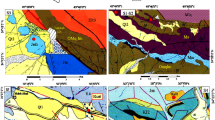Summary
A combined experimental and numerical approach is adopted to investigate crack propagation in sandstone. Experiments on two types of sandstones show a simular behaviour as found in tests on concrete specimens. The heterogeneity of the material in combination with the stress situation, as a result of the applied load, governs the direction of crack propagation. Cracks that develop are not continuous, but overlaps exist mainly around the grain particles in the material. A simple lattice model, in which the material is schematized as a network of small beams, is adopted to simulate the experiments. Using the simulations carried out with the lattice model, the control parameter for stable displacement controlled four-point-shear tests was determined. The crack patterns obtained with the model are in good agreement with the experimental observations. However further study is needed to predict the load-displacement response correctly.
Similar content being viewed by others
References
Bažant, Z. P., Pfeiffer, P. A. (1986): Shear fracture test of concrete. Mater. Struct. (RILEM) 110 (19), 111–121.
Bažant, Z. P., Tabbara, M. R., Kazemi, M. T., Pijaudier-Cabot, G. (1990): Random particle model for fracture of aggregate or fiber composites. J. Engng. Mech. Div. ASCE 116 (8), 6686–1705.
Berg, A., Svensson, U. (1991): Datorsimulering och analys av brottfvrlopp i en heterogen materialstruktur, Report No. TVSM-5050, Lund Institute of Technology, Division of Structural Mechanics, Lund, Sweden (in Swedish).
Burt, N. J., Dougill, J. W. (1977): Progressive failure in a model heterogenous medium, J. Engng. Mech. Div. ASCE 103 (3), 365–376.
Herrmann, H. J., Hansen, H., Roux, S. (1989): Fracture of disordered, elastic lattices in two dimensions, Phys. Rev. B 39 (1), 637–648.
ISRM (1979): Suggested methods for determining the uniaxial compressive strength and deformability of rock materials, Int. J. Rock Mech. Min. Sci. Geomech. Abstr. 16, 135–140.
Moukarzel, C., Herrmann H. J. (1992): A vectorizable random lattice, Preprint HLRZ 1/92, HLRZ-KFA Jülich, Germany.
Schlangen, E. (1993): Experimental and numerical analysis of fracture processes in concrete, PhD-thesis, Delft University of Technology, Delft, 121.
Schlangen, E., Van Mier, J. G. M. (1992a): Fracture modelling of granular materials. In: Mark, J. E., Glicksman M. E., Marsh S. P. (eds.), Computational methods in materials science, MRS Symposium Proc. Vol. 278, Pittsburgh, 153–158.
Schlangen, E. Van Mier, J. G. M. (1992b): Experimental and numerical analysis of micromechanisms of fracture of cement-based composites. Cem. Concr. Compos. 14, 105–118.
Schlangen, E., Van Mier, J. G. M. (1992c): Micromechanical analysis of fracture of concrete, Int. J. Damage Mech. 1, 435–454.
Schlangen, E., Van Mier, J. G. M. (1994): Fracture simulations in concrete and rock using a random lattice. In: Siriwardane, H. J., Zaman, M. M. (eds.), Computer methods and advances in geomechanics, Balkema, Rotterdam, 1641–1646.
Schorn, H., Rode, U. (1987): 3-D-modeling of process zone in concrete by numerical simulation, In: Shah, S. P., Swartz, S. E. (eds.), Proc. SEM/RILEM Int. Conf. Fracture of Concrete and Rock Springer, Wien New York, 220–228.
Van Mier, J. G. M. (1990): Fracture process zone in concrete: a three dimensional growth process, In: Firrao, D. (ed.), Fracture behaviour and design of materials and structures, EMAS Publishers, Warley, 567–572.
Van Mier, J. G. M. (1991): Mode I fracture of concrete: discontinuous crack growth and crack interface grain bridging. Cem. Concr. Res. 21, 1–15.
Van Mier, J. G. M., Schlangen, E., Vervuurt, A. (1993): Analysis of fracture mechanisms in particle composites, In: Huet, C. (ed.), Micromechanisms of concrete and cementitious composites, Presses Polytechniques et Universitaires Romandes, Lausanne, 159–170.
Van Mier, J. G. M., Visser, J. H. M. (1993): Fundamental fracture mechanics in concrete and sandstone, Research report 25.5-93-5, Delft University of Technology, Stevin Laboratory, Delft.
Zubelewicz, A., Bažant, Z. P. (1987): Interface modeling of fracture in aggregate composites. J. Engng. Mech. Div. ASCE 113 (11), 1619–1630.
Author information
Authors and Affiliations
Rights and permissions
About this article
Cite this article
Schlangen, E., Van Mier, J.G.M. Crack propagation in sandstone: Combined experimental and numerical approach. Rock Mech Rock Engng 28, 93–110 (1995). https://doi.org/10.1007/BF01020063
Issue Date:
DOI: https://doi.org/10.1007/BF01020063




